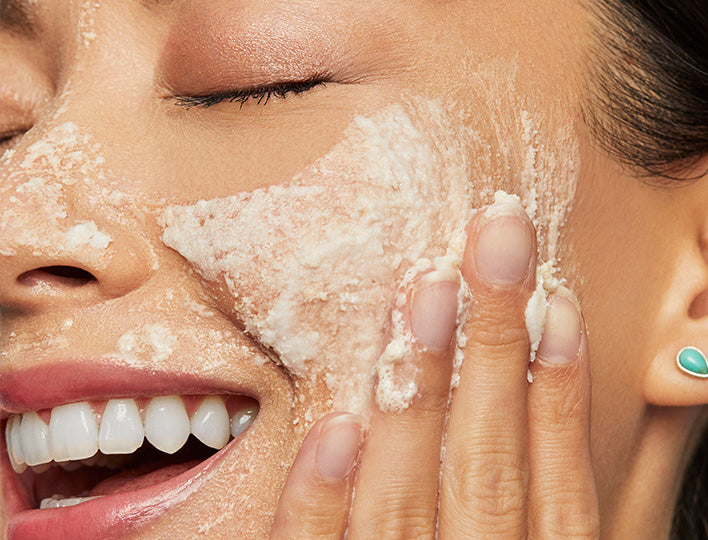How to Exfoliate: Tips for Each Skin Type
Written by: Lydia Bell
Every skincare article or video talks about exfoliation like it's the holy grail, a truly essential step of your skincare routine. However, it’s sometimes easy to bypass exfoliation, especially when we’re tired or short on time. But we really shouldn’t: exfoliation is a vital skincare step that effectively eliminates dead skin cells from the surface, promoting a brighter and smoother complexion while enhancing blood circulation. However, it's crucial to choose the appropriate exfoliation method based on your skin type and condition, as excessive exfoliation can exacerbate certain issues like rosacea or sensitivity.
In this post, we’ll cover essential tips on how to exfoliate your skin properly, based on your skin type, the difference between exfoliation methods, and how to choose the right exfoliator for you!

The Two Types of Exfoliators
Manual Exfoliators
Exfoliating Washcloth - An exfoliating washcloth is a gentle yet effective method of manual exfoliation. Made from soft fabrics like microfiber or muslin, these cloths help slough away dead skin cells when used with a facial cleanser. To use, dampen the washcloth with warm water and apply a small amount of cleanser before gently massaging the skin in circular motions.
Exfoliating Skin Scrub - Exfoliating skin scrubs typically contain physical granules or particles that work to manually buff away dead skin cells. These granules can be made from various materials like sugar, salt, or jojoba beads. When massaged onto damp skin, the scrub helps to dislodge buildup and impurities from pores. It's essential to choose a scrub with smooth, rounded particles to avoid causing micro-tears in the skin.
Exfoliating Brush - An exfoliating brush features soft bristles designed to gently sweep away dead skin cells and impurities from the skin's surface. The bristles help to stimulate circulation and promote cell turnover. To use, apply a facial cleanser to damp skin and gently massage the brush in circular motions. Be sure to choose a brush with ultra-soft bristles to prevent irritation.
Exfoliating Cleansing Device - These innovative devices feature silicon bristles that provide gentle yet thorough exfoliation. The soft, non-abrasive bristles effectively remove dead skin cells, makeup residue, and excess oil from the skin's surface without causing irritation. Additionally, the silicon material is hygienic and easy to clean, making it suitable for daily use.

Chemical Exfoliators
Alpha Hydroxy Acids (AHAs) - Alpha Hydroxy Acids, such as glycolic acid and lactic acid, are water-soluble acids derived from fruits, milk, or sugar cane. These acids work by loosening the bonds between dead skin cells, revealing newer, fresher skin underneath. Glycolic acid, with its smaller molecular size, penetrates deeply into the skin, making it effective for addressing fine lines, texture, and hyperpigmentation. Lactic acid has larger molecules and offers gentler exfoliation, making it suitable for sensitive skin types.
Beta Hydroxy Acids (BHAs) - Beta Hydroxy Acids, such as salicylic acid, is oil-soluble and penetrates deep into the pores to dissolve sebum, dead skin cells, and other impurities. This makes BHAs particularly effective for treating acne, blackheads, and blemishes. Salicylic acid has anti-inflammatory properties, helping to calm redness and irritation associated with acne-prone skin. Additionally, BHAs help to regulate oil production and prevent future breakouts by keeping the pores clear and unclogged.
Poly Hydroxy Acids (PHAs) - Poly Hydroxy Acids, such as gluconolactone and lactobionic acid, are a newer generation of exfoliating acids known for their gentle yet effective exfoliation properties. PHAs work by breaking down the bonds between dead skin cells on the surface of the skin, resulting in smoother and brighter skin. Unlike AHAs and BHAs, PHAs have larger molecular structures, making them less likely to cause irritation or sensitivity, making them suitable for sensitive and rosacea-prone skin.

How To Exfoliate Your Skin By Skin Type
Dry Skin
Exfoliation plays a crucial role in managing dry or flaky skin, but it's essential to avoid mechanical exfoliation methods as they can exacerbate dryness and cause micro-tears in the skin’s surface. Alpha Hydroxy Acids (AHAs), like glycolic acid, are particularly gentle and effective for dry skin. However, it's crucial to follow up with sunscreen and moisturizer after using glycolic acid to protect the skin from increased sun sensitivity.
Mature Skin
For mature skin, both chemical and manual exfoliation can offer benefits, but use a gentle approach. Chemical exfoliants containing alpha hydroxy acids (AHAs) like glycolic acid or beta hydroxy acids (BHAs) such as salicylic acid can effectively dissolve dead skin cells and encourage cell turnover, promoting a more youthful complexion. Manual exfoliation using gentle scrubs or brushes physically removes dead skin cells, revealing fresher, brighter skin underneath.
Sensitive Skin
When dealing with sensitive or easily irritated skin, it's crucial to steer clear of harsh mechanical exfoliation methods that can exacerbate irritation and cause redness. Instead, opt for a gentle approach by incorporating mild chemical exfoliators into your skincare routine. These products, such as those containing Alpha Hydroxy Acids (AHAs) or Beta Hydroxy Acids (BHAs), work to dissolve dead skin cells without the need for abrasive scrubbing.
Combination Skin
Combination skin often benefits from a combination of mechanical and chemical exfoliation techniques. Some people like to use manual exfoliators on the oilier parts of their face, and chemical exfoliators on the drier parts. Keep in mind to start off gently and not overdo it by mixing too many methods, in order to avoid irritation. If your skin feels dry post-exfoliation, follow up with a moisturizer to replenish hydration.
Oily Skin
For individuals with oily or thicker skin types, chemical exfoliators work very well. Manual exfoliation and brushing can also work wonders. Oily skin often harbors an excess buildup of dead skin cells and impurities on its surface, which manual exfoliation methods can effectively eliminate. By gently employing an exfoliator or scrub in circular motions, the skin can be thoroughly cleansed, resulting in a clearer and smoother complexion.
Normal Skin
For normal or balanced skin types without many issues, both manual and chemical exfoliation methods are suitable and safe choices. Whether you prefer manual scrubbing or chemical treatments, experiment with a few different methods in order to determine the most effective method for your skin's unique needs.
Our Best Exfoliating Products
Best for Normal Skin: Elemis Gentle Rose Exfoliator
This rose-scented skin-smoothing exfoliator gently buffs away dirt and dead skin cells to reveal a soft and smooth complexion. Cucumber extract soothes and refreshes.
Best For Oily Skin: Murad Vita-C Triple Exfoliating Facial
Triple exfoliating facial is clinically proven to smooth texture as effectively as a microdermabrasion facial—in just one use. Gold-stabilized vitamin C, with 55% more antioxidant power than traditional vitamin C, supports healthier-looking skin and a brighter, more even tone.
Best For Sensitive Skin: Yon-Ka Gommage
A pampering peeling gel exfoliant that is a 4-in-1 facial peel that possesses an extraordinary exfoliating, clarifying, hydrating, and balancing effect in one. This non-irritating formula is good for all skin types, even sensitive and acne-prone.
Best For Dry or Mature Skin: Elemis Pro-Collagen Tri-Acid Peel
Reveal a complexion that looks fresh, youthful and rejuvenated with this innovative line-refining peel. Formulated with an 8% Tri-Acid Complex of Lactobionic, Asiatic and Mandelic Acids, it lifts away dull and dead skin cells for a smoother and renewed-looking appearance.
Best for Combination Skin: Peter Thomas Roth Peptide 21 Exfoliating Peel Pads
Exfoliating peel pads saturated with peptide-building Amino Acids, and a 20% Exfoliating Complex of Phytic Acid, Salicylic Acid help reduce the look of pores, uneven skin tone, texture, fine lines and wrinkles while prepping skin for the next steps.







